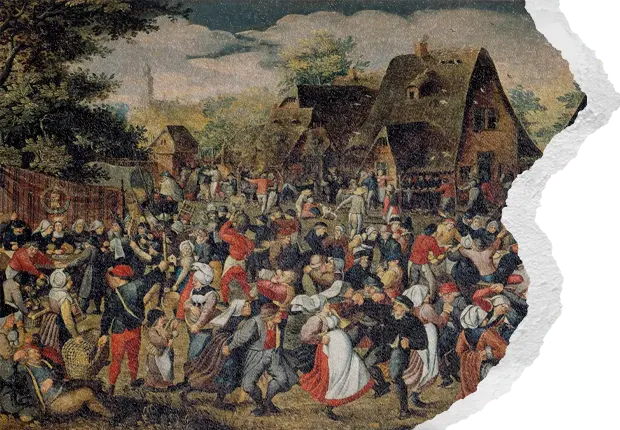The Village and the Warband
The countryside and the village have always loomed large in the minds and dreams of traditionalists. The country farm, even in Roman times, represented an idyll that stood in the starkest contrast to the growing cities, especially Rome, and the life of business that was carried on there. The very word for this urban business in Latin, negotium, means “the opposite of leisure” (otium) – quite literally, “the negation of otium”. Otium et bellum – leisure and war – were the twin poles of the ancient aristocratic life, says Nietzsche, and it already seemed clear to some that living in a city was, by its very nature, a deviation from the true higher course of being. “Blessed is he,” wrote the poet Horace, “who, far from the busy life [negotiis] tends his paternal herds like the earlier race of men, free from all borrowing and lending”.
And so the countryside and the village have remained ever since: a timeless place where the real meaning of life could be apprehended and, hopefully, pursued. Even in their sneering condescension, the urbanite and metropolitan have done their bit to fashion this image of the country and village as a place apart, where all that is solid does not melt into thin air. On the right side of Twitter, the benefits of country and village life continue to be championed in the many return-to-tradition memes, something I’ve talked about at length elsewhere (The Asylum, Issue One), and in countless traditionalist Twitter accounts in the Wrath of Gnon mould.
An initial problem, if we choose to make the village our ideal traditional community, is that the modern-day village is not what it once was, certainly not in England anyway. And I should know, since I’ve spent a decent portion of my life in a number of very beautiful English villages none of which could qualify as a real, living place. Sure, the lovely medieval church may still be there and the picturesque thatched houses are mostly still intact, despite the intrusion of some modern homes and council housing; and sure, there are still people living in the houses, at least for a portion of the year. The truth is, though, that these places have no real animating force. Without an independent economic life of their own – no trades or small businesses – and because the price of properties has become so inflated, and the supply is limited, the young have no real place there and are inevitably pushed out. If young people do move to the village, they won’t be the children of locals but affluent couples looking to escape the city rat-race and start a family in more congenial surroundings. The ancient customs, tied to the rhythms of the agricultural seasons, are almost entirely gone, as you’d expect; those that do survive are mere curiosities, like the people who maintain them. Some life remains in the local pub – if your village is lucky enough to have one, that is. So the modern English village is not, like the fictional Cheers, a place where everybody knows your name – but it is somewhere where the locals will at least recognise your car, especially if you drive down for the weekend in your brand new Tesla.
These aren’t changes that have happened overnight. If you want to know more about the English case, I’d suggest reading Ronald Blyth’s Akenfield, the story of a semi-fictional Suffolk village, beginning in the late 1800s and ending in the 1960s, when the book was written. No, you’re going to have to go far back if you want a model of village life that isn’t a hollow one, stripped of its true purpose and dependent on the wealth of the city for fresh infusions of money and vitality. Simply moving to villages en masse is not a viable strategy for a traditionalist revival today.
Besides the formidable practical difficulties that would be involved in making villages come to life again, in any form, in the present, there’s the question of whether this would actually be a desirable thing in the first place. I’d wager many who call for a return to village life a) haven’t actually spent that much time in villages and /or b) know little about what it was like to live in one historically, in what we might call “the golden age of the village”. They might be surprised to know that many of the problems they rail against, thinking them to be symptoms of the modern condition, were in fact present way back when, and in just as vicious and unappealing forms as we find today.
As Bronze Age Pervert puts it, forcefully, in Bronze Age Mindset (p.106):
“The life of the village and of the primitive is one of utter subjection, total domestication and total brokenness. The ‘matriarchy’ that does exist, and that exerts enormous influence and power in the social and moral realm, is only the manifestation of this brokenness of the males. Communal solidarity absorbs and snuffs out any personal distinction or intelligence and this task is relatively easy where it concerns the majority of the parts of the village: the real problem becomes what to do with the young males.”
Which is to say, if you’re a young man driven mad by the ever-narrowing confines of modernity’s iron cage, you’d almost certainly be just as mad if you woke up tomorrow in a medieval village – Montaillou, in the French Pyrenees, perhaps. Pretty soon you’d discover that the Karen who was watching your every move in the office – waiting for something “inappropriate” to report to HR so she could leapfrog you to promotion – had been replaced by a seamstress called Beatrice who watched you at night through a hole in your roof, hoping you’d say something heretical to your family so she could go tell the local bishop and have your property confiscated. Out of the frying pan and into the fire – quite literally if you weren’t careful… But don’t just take my word for it; medieval Montaillou is the subject of a wonderful book of the same name by the French historian Emmanuel Le Roy Ladurie, and it reveals in great detail what peasant life there was really like.
Situated on a plateau in the Pays d’Aillon, in the foothills of the Pyrenees, Montaillou was a village of between 200 and 250 inhabitants at the beginning of the fourteenth century. The village was principally a farming community (crops and animals), with a small contingent of artisans and a larger number of itinerant shepherds. We know so much about Montaillou because the village fell under the gaze of the Church’s Inquisition and many of the inhabitants were interrogated – and at least one burned – by the local bishop on suspicion of being Cathar heretics. What emerges from the wealth of surviving testimony is, among other things, a sense of just how utterly stifling life was for the inhabitants of the village.
In Montaillou, village life revolved around the household, or domus, which encompassed both the house itself and the family (and animals) within it; the domus assumed a biological, economic, mystical and religious significance, at once. There is much talk on Twitter of the benefits of the “multi-generational household” – well, this what it actually looked like. The generations dwelling within the domus were considered also to include the dead, who were thought to guard its good future and therefore had to be regularly appeased by the living. On the day-to-day, the domus was the principal unit in the agricultural division of labour and the means by which resources were allocated, whether among its members or to the various powers, civil and ecclesiastical, that ruled over the local area. The chief long-term concern of the head of the household, who was usually male but sometimes female, was the proper descent of the domus and its humble resources. Marriage customs were such that marriages outside the domus, although inevitable, were considered a kind of tragic threat to its integrity. The local priest recognised this with a bitter irony when he said that it would be best, for the domus at least, for brother to marry sister, rather than receive a stranger for a wife or be given away to another man along with a dowry the household could precious afford. The needs of the domus, not the individual, always came first, and it’s hard to doubt that such unions would actually have taken place had they been allowed.
Although a man might try to rule his domus with an iron rod, authority within the household was far from straightforward. Regardless of their formal power in medieval French society, the women wielded a variety of soft powers that proved no less crushing than a formal matriarchy would have. The majority of men in Montaillou appear to have been thoroughly hagridden by their wives and lovers (affairs were common). It’s unsurprising, then, that so much of the official testimony to the bishop consists of men insulting the women around them, the sole exception being their own mothers. The wives and women are variously “old women”, “old sows” and “old heretics”. Male servants would often take their masters’ side when they insulted their wives. “Bad mother, devil!” was one insult spouted by master and servant alike, and not the only time it was doubted whether these women were really women at all, or something far worse. “Women are demons,” another servant stated, matter-of-factly. The swiving local priest, having married off his pregnant mistress in order to save his reputation, told the couple that “A man is nothing if he is not his wife’s master” – pointing to the obvious fact that the majority of men were not.
This “total domestication”, as Bronze Age Pervert puts it, was made yet worse through endemic conflict, and not just because the men were emasculated and the presence of multiple generations in a single home is almost always a recipe for bitter resentment and scheming. The testimony that the villagers gave before the bishop is unequivocal evidence that virtually nothing went unnoticed by someone – privacy, whether from one’s own family or from the neighbours, simply did not exist. Owing to the ramshackle construction of the village houses, it was easy to hear or see what was going on inside at any time. Internally, the walls were so thin that it was all-but impossible to have a private conversation if others were in the house, as they invariably were, and outsiders could quite literally lift a corner of the roof up to peer inside; this was particularly effective at night, when the inhabitants would be huddled around the light and warm of the hearth, and the observer cloaked in darkness. Many houses didn’t even have front doors, but ill-fitting planks or slats – another boon for nosy neighbours. It’s fashionable to claim, after Foucault, that modern man lives in a panopticon, where his every move and every word is surveilled by unseen forces, but this was hardly less the case in Montaillou, and in the febrile atmosphere of heresy and the Inquisition, the spying and snooping that were part and parcel of village life took on a truly monstrous aspect.
Aloof from this domestic hell, masters of their fate alone, were the shepherds of the village. It was a common classical trope that the wandering shepherd enjoyed a kind of blessed freedom, unbothered by the cares and customs of the settled world, and nowhere was this more so than in Montaillou. Although the book’s main character is the randy priest Pierre Clergue, it is another Pierre, Pierre Maury, a happy and magnanimous shepherd, who is the real hero of the story. Like the other shepherds of the region, Maury followed his flocks into the mountains during the season, leaving behind the village and its residents. Freed from the bonds of place, property and lineage, the shepherds came together in voluntary groupings of friendship as they roamed the mountain passes and pastures. This vagabond life also resulted in a different mental outlook, more philosophical, more prone to lofty thoughts and much less superstitious than that of the villagers. Up in their mountain strongholds, the shepherds were untouchable, and many, including Pierre Maury, took advantage of this fact to evade the strong arm of the Church when it reached for them.
“[Maury’s] destiny was a destination. For him, sheep meant liberty. And he would not trade that liberty for the plate of gritty lentils often held out to him by friends, employers or parasites, offering to marry him, to help him settle down, to have him adopted into a rich family. But he saw his destiny as travelling over hill and dale, with friends everywhere and temporary sweethearts. Material wealth would have been literally a burden to him. Maury had few possessions, but he was not destitute.”
In this description of Maury’s life, there is a very striking echo of some things the Roman historian Tacitus wrote in the Germania, and they point the way to an alternative model of “trad” life in Europe, one that is barely less ancient than the village and potentially much more promising.
As he runs through the martial customs of the ancient Germans, Tacitus notes how the young men who would form the companions, or comitatus, of the great war chiefs could never settle down to peace, but would instead wander in search of other battles and other chiefs in whose service they could win further glory and distinction.
“Whenever their own people is numbed by long peace, the better part of the noble youths choose to seek out other peoples at war, since they find peace disagreeable and fame is more easily found among danger. A great retinue cannot be maintained but through violence and war. For the companions demand from the liberality of their chief the horse made for battle, the bloodied and winning spear. Feasts and gear – gaudy but copious – are their salary.”
Like Pierre Maury and his fellow shepherds, these men voluntarily forsook the settled life and its regularities – place, property, work, comfort. They too would wander and find their own fate, rather than waiting for it to find them. “You could not so easily persuade them to till the soil and await the harvest,” says Tacitus, “as to challenge the enemy and win their wounds.” The creed they followed was simple: “Why earn with sweat what you can take with blood?”
Tacitus describes another similar custom, most prevalent among the Chatti, a particularly ferocious tribe. When a young man reached maturity, he would not shave his hair or beard until he had killed a man. Standing over the victim’s corpse, his hair would be shaved and he would declare himself a man and a worthy son and member of his people. But some took this custom yet further, remaining permanently unshorn and also wearing an iron ring “like a fetter”. These men were a marvel to behold, and lived a life devoted solely to battle. They would always make up the first line on the battlefield, Tacitus says. “They have no home, farm land or other cares. They feed themselves at the table of whomever they encounter, wasteful of what the host provides, contemptuous of what is their own – until pale old age makes them unequal to such harsh virtue.”
But the Germans were not the first to live this roaming life. In fact, if we want to look for its origins and impetus, we should look much further back in time, to the very birth of the European peoples. To simplify a little, the genetic character of Europeans was fixed through a series of migrations from two sources: first by Neolithic farmers from modern-day Turkey (c. 9,000 years ago) and then by steppe pastoralists (c. 5,000 years ago) from the Pontic-Caspian steppe. In light of a number of revolutionary genetic studies in the past six years, the Yamnaya, the principal steppe people in question, have been called “the most murderous people of all time” (New Scientist) and “the most violent group of people who ever lived” (Daily Mail) – with good reason. While the Neolithic farmers who made the earlier journey into Europe brought their families with them, the genetic studies have made it clear that the Yamnaya migration was basically one big mounted warband which either killed or enslaved the Neolithic men of Europe and took their women as wives. Academics like David Reich, who have been instrumental in advancing this theory, are now doing their best to walk back the full implications of the genetic data they have revealed but – horse, stable door, bolted. No amount of wishful academic thinking, motivated by the desire not to stir “dark” currents in Europeans’ thinking about who they really are, can hide what has been revealed. As much as the establishment of settled farming communities, the origins of the European peoples lie in a wild, bloody ride of young warriors off the steppe.
Why did the Yamnaya leave their homes? Perhaps, like among the Germans, it was already an established custom for the young to band together and wander in search of their fortune. But given the scale on which the migrations must have taken place – “massive steppe migration” is the phrase used by the scientists, including David Reich – this seems unlikely. Much more likely is that population pressures on the steppe, and perhaps even political crisis, forced a large number of young, unaccompanied men to move on and create their own opportunities. It’s worth noting that, as dynamic as the pastoralist lifestyle may be, these societies are just as prone to conflict and sclerosis as settled ones.
To wander in pursuit of blood or glory remained an alternative way of life right through the Middle Ages and into the modern era, not just in weakened form as we’ve seen with the shepherds of the Pyrenees, but also in full-blown, full-blooded, form as well. Says Bronze Age Pervert: “This was also the attitude of the medieval knight, the chevalier, the Rittern, the riders who considered the life of the serf, of the community, to be mean and dirty, worthy of slaves and low-castes and women: they were always ready to ride away to new things and new adventures of glory and danger.” This attitude would carry the earliest European colonisers overseas as well, even in the absence of any European tradition of sailing at that time.
The early days of the colonial enterprise, such as when the Spaniards expanded from their island colonies in the Caribbean into Mexico and beyond, were a time of perhaps unparalleled individual initiative and glory, when small groups of determined men could achieve seemingly impossible feats. Take Cortés, for instance. When he arrived on Hispaniola as a minor gentleman from one of the poorer regions of Spain, he arrived too late: the major land grants, with their allotments of native slaves (encomiendas), had already been parcelled out. Realising he would find no fortune on the island, he and other men who shared his predicament looked elsewhere, taking part in a number of locally raised expeditions before the famous conquest of Mexico in 1520-21, which was achieved without the proper approval of the Crown or its agents in the New World. People remember that when Cortés arrived on the Yucatan he burnt his ships, to prevent the expedition from turning back and thus focus minds on victory, but they tend to forget that he was pursued as keenly by his rivals on Hispaniola as the Aztecs, and had to head off a number of parties sent to arrest and return him to the island to answer for his arrogance. When the conquest was over, the first thing Cortés did was return to Spain to plead his case – retrospectively – before the Crown. This is just one of a thousand similar stories that could be told, whether of the Spanish, Portuguese, English, French or Dutch in the great Age of Exploration and Conquest.
*
I’ve done my best to show you that the village is not what many traditionalists think it is or indeed ever was. Although Montaillou might not have been completely typical, it expressed many of the worst possibilities latent in the form – for domesticity to become total, for individual privacy and initiative to be swallowed up whole, and for proper authority to degenerate into a joyless, saggy-breasted matriarchy. There’s no reason to believe that a revival of small communities today – assuming that such a thing is even possible, especially at scale – would not actually make many of the problems all of us hate, so very much worse. A new localism could easily become an intimate tyranny far beyond our worst possible nightmares, bolstered by advances in modern technology, and perhaps drawing its justification from Christianity in its wretched present state. Christianity today, which is no different from the language of “social justice”, is not the religion which sustained life in the Middle Ages, and seems incapable of doing anything other crushing and twisting life.
Whatever the reason why the Yamnaya left the steppe, there can be no doubt that the decision was a world-historical event. Nor would it be too much of a stretch to say that it helped establish a tension that has remained at the heart of European civilisation ever since: the life of the village or the life of the warband. A settled life has never been the only option, and it need not be so now. Rather than building villages, perhaps we should be building warbands instead, waiting for a time soon when they can ride forth once more and make their own destiny – just like they’ve been doing for the past five thousand years.
































